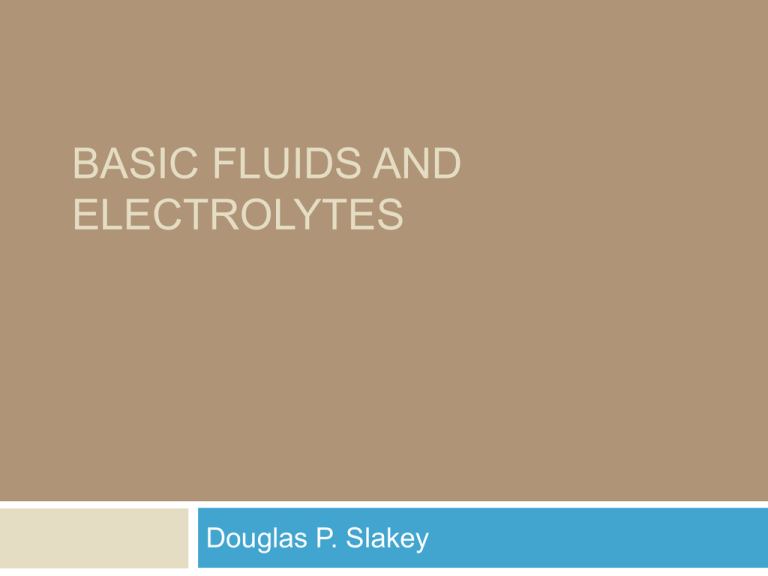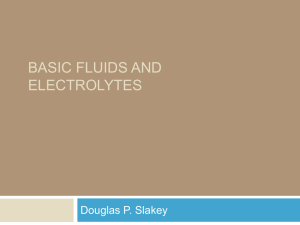ALL NEW FOR 2005(6)! Fluids and Electrolytes Made Simple
advertisement

BASIC FLUIDS AND ELECTROLYTES Douglas P. Slakey Why ? Essential for surgeons (and all physicians) Based upon physiology Disturbances understood as pathophysiology To Encourage Thought Not Mechanical Reaction Most abnormalities are relatively simple, and many iatrogenic It’s All About Balance Gains and Losses Losses Sensible and Insensible Typical adult, typical day Skin Lungs Kidneys Feces 600 ml 400 ml 1500 ml 100 ml Balance can be dramatically impacted by illness and medical care Fluid Compartments Total Body Water Relatively constant Depends upon fat content and varies with age Men 60% (neonate 80%, 70 year old 45%) Women 50% TOTAL BODY WATER 60% BODY WEIGHT ECF ICF 2/3 H2O 1/3 Predominant solute Predominant solute K+ Na+ I LOVE SALT WATER! Electrolytes (mEq/L) Na K Ca Mg Cl HCO3 Protein Plasma 140 4 5 2 103 24 16 Intracellular 12 150 0.0000001 7 3 10 40 Fluid Movement Is a continuous process Diffusion Solutes move from high to low concentration Osmosis Fluid moves from low to high solute concentration. Active Transport Solutes kept in high concentration compartment Requires ATP Movement of Water Osmotic activity Most important factor Determined by concentration of solutes Plasma (mOsm/L) 2 X Na + Glc + BUN 18 2.8 Third Space Abnormal shifts of fluid into tissues Not readily exchangeable Etiologies Tissue trauma Burns Sepsis Fluid Status Blood pressure Check for orthostatic changes Physical exam Invasive monitoring Arterial line CVP PA catheter Foley Case 1 6 month old boy, born full-term Developed worsening vomiting during the past week Today he is listless, irritable, not tolerating oral intake Pulse 145, BP 70/50 Diaper is dry, anterior fontanel depressed Case 1 Labs 149 92 12 2.8 40 0.8 12.3 15 45 200 Case 1 F & E Problem List Hypovolemia Hypernatremia Hypokalemia Alkalosis 149 92 12 2.8 40 0.8 Volume Deficit Most common surgical disorder Signs and symptoms CNS: sleepiness, apathy, reflexes, coma GI: anorexia, N/V, ileus CV: orthostatic hypotension, tachycardia with peripheral pulses Skin: turgor Metabolic: temperature Dehydration Chronic Volume Depletion Affects all fluid components Solutes become concentrated Increased osmolarity Hct can increase 6-8 pts for 1 L deficit Patients at risk: Cannot respond to thirst stimuli Diabetes insipidus Treatment: typically low Na fluids Hypovolemia Acute Volume Depletion Isotonic fluid loss, from extracellular compartment Determine etiology Hemorrhage, NG, fistulas, aggressive diuretic therapy Third space shifting, burns, crush injuries, ascites Replace with blood/isotonic fluid » Appropriate monitoring » Physical Exam » » Foley (u/o > 0.5 ml/kg/min) Hemodynamic monitoring Treatment – Patient weight is 12 kg Fluid choice? Replace volume Replace Cl How to order “Bolus” Think about rate over time Adequate access important What would maintenance fluid choice and rate be? 4-2-1 rule Why not replace K right away? Acid – Base Balance Acidosis May result from decreased perfusion i.e. decreased intravascular volume K will move out of cells Alkalosis Complex physiologic response to more chronic volume depletion i.e. vomiting, NG suction, pyloric stenosis, diuretics K will move intracellular Paradoxical Aciduria Hypochloremic Hypovolemia Na Na H Cl K Loop of Henle Case 1 When should we operate? Need to wait until adequately resuscitated Why Monitor by: Normalized vital signs Good urine output Normalized labs Case 2 64 year old, had colon resection 5 days ago “doing well” ….until…. Suddenly develops atrial fibrillation with rapid ventricular response P 120, irregular; BP 115/70; RR 20 Temp 38.7 Confused, anxious Case 2 Labs 128 100 12 3.0 22 0.8 16.3 10 30 180 Mg 1.1 Case 2 Diagnoses? New onset A fib, why? Hypervolemia Hyponatremia Hypokalemia Hypomagnesemia Anemia Case 2 Why does patient have hypervolemia? Increased Antidiuretic Hormone (ADH) Causes Surgical stress (physiologic) Cancers (pancreas, oat cell) CNS (trauma, stroke) Pulmonary (tumors, asthma, COPD) Medications Anticonvulsants, antineoplastics, antipsychotics, sedatives (morphine) Hyponatremia – how to classify Na loss True loss of Na Dilutional (water excess) Inadequate Na intake Classified by extracellular volume Hyovolemic (hyponatremia) Diuretics, renal, NG, burns Isotonic (hyponatremia) Liver failure, heart failure, excessive hypotonic IVF Hypervolemic (hyponatremia) Glucocorticoid deficiency, hypothyroidism Patient was receiving maintenance Fluids D5 0.45NS + 20 mEq KCl/L at 125 ml/hr How much Sodium is Enough??? NS 0.9% = 9 grams Na per liter 0.45 NS = 4.5 grams per liter 125 ml/hour = 3000 ml in 24 hours 3 liters X 4.5 grams Na = 13.5 GRAMS Na! (If 0.2 NS: 3 liters X 2 grams Na = 6 grams Na) Case 2 - How to treat A fib: ACLS protocol Correct electrolytes Replace Mg and K Decrease volume, fluid restriction Case 3 23 year old with jejunostomy Had colon and ileum resected due to injury Tolerates some oral nutrition, but has high output from jejunostomy (2.5 liters per day), therefore requires TPN P 118, BP 105/60 Case 3 Labs 154 114 28 3.2 16 2.4 10.3 9.7 28 380 Glucose 213 Mg 1.4 Current Problems Hypovolemia Increased plasma osmolarity 2 X 154 + (213/18) + (28/2.8) = 329.8 Hypernatremia Renal insufficiency Acidosis Case 3 - Hypovolemia Fistula output High volumes can rapidly lead to dehydration Electrolyte composition can be difficult to estimate Can send aliquot to laboratory May need to be replaced separately from maintenance (TPN) fluids Hyperglycemia Hypernatremia Relatively too little H2O Free water loss (burns, fever, fistulas) Diabetes insipidus (head trauma, surgery, infections, neoplasm) Dilute urine (Opposite of SIADH) Osmotic diuresis Nephrogenic DI Kidney cannot respond to ADH Too much Na, usually iatrogenic Hypernatremia Free water deficit: [0.6 X wt (kg)] X [Serum Na/140 - 1] Example: Na 154, 60 kg person (0.6 X 60) X [(154/140) - 1] 36 X [1.1 -1] 36 X 0.1 = 3.6 Liters Case 3 – How to Treat 154 114 28 3.2 16 2.4 Correct hyperglycemia Replace pre-existing volume deficits Reduce ostomy output if possible What to do with: Acidosis? Hypokalemia? Case 4 58 year old, had a recent kidney transplant Laboratory calls with critical value: Potassium 5.9 What to do? Case 4 Evaluate the patient Exam ECG Order repeat labs Hyperkalemia - Common Causes Spurious Blood drawn above running IV Underlying disease Renal failure Rhabdomyolysis Associated medications Too much K+, ACE inhibitors, beta-blockers, antibiotics, chemotherapy, NSAIDS, spironolactone Treatment Mild: dietary restriction, assess medications Moderate: Kayexalate Do not use sorbitol enema in renal failure patients Severe: dialysis Potassium and Ph Normally 98% intracellular Acidosis Extracellular H+ increases, H+ moves intracellular, forcing K+ extracellular Alkalosis Intracellular H+ decreases, K+ moves into cells (to keep intracellular fluid neutral) Hyperkalemia - Treatment Emergency (> 6 mEq/l) Monitor ECG, VS Calcium gluconate IV (arrhythmias) Insulin and glucose IV Kayexalate, Lasix + IVF, dialysis Mild to Moderate Mild: dietary restriction, assess medications Moderate: Kayexalate Do not use sorbitol enema in renal failure patients Severe: dialysis The End Makani U’i Remember JVD?

